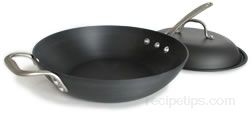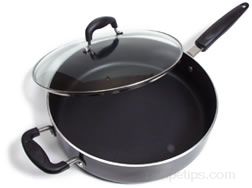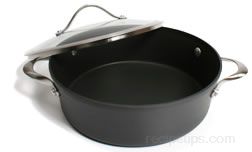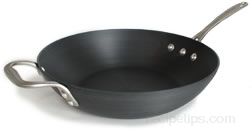KITCHEN PANS - Saucier Pan to Stir-Fry Pan
SAUCIER PAN
 As a shorter and different shaped version of a sauce pan, the saucier is a pan often
used for preparations requiring more repetitive motions with the ingredients in
the pan, such as stirring or whisking. The saucier pan will not have sides as deep
as a sauce pan, but may have straight-edged or broadly curved sides that rise up
at a slight angle, making the mouth wider than the base. Thus, the shorter sides
enable easier access to the ingredients when preparing foods such as sauces, custards,
puddings, rice dishes, and accomplishing tasks such as braising, poaching, sautéing
or reducing liquids. Pan bottoms will be much thicker than the sides, allowing heat
to be evenly distributed and retained. When selecting, consider the functions that
will most often occur with the use of this pan. Determine if the depth and width
of the mouth are sufficient for ease of access to accomplish repetitive motions
and that it is not too small in diameter requiring tighter rotations to occur with
the hand or arm. Similarly, if the tasks are generally for small amounts of ingredients,
smaller pan sizes should be considered. Common saucier pan sizes range from 1 to
5.5 quarts with diamaters of 7 to 13 inches. Check the rim of the pan as some pans
may not have a lip formed around the rim, so pouring liquids becomes a messy task.
Grasp the handle to see if it is comfortable and has sufficient length to resist
becoming hot after being on a stovetop burner for longer periods of time. Although
price may be a factor, consider the materials used to construct the pan, making
sure it will evenly heat across the surface of the pan, such as a cladded, anodized
or other similar materials will enable. A saucier pan may also be referred to as
a chef's pan or a reduction saucepan. The functions often served by this pan and
the appearance of the pan are very similar to a skillet, a fry pan, an omelet pan,
or a stir-fry pan.
As a shorter and different shaped version of a sauce pan, the saucier is a pan often
used for preparations requiring more repetitive motions with the ingredients in
the pan, such as stirring or whisking. The saucier pan will not have sides as deep
as a sauce pan, but may have straight-edged or broadly curved sides that rise up
at a slight angle, making the mouth wider than the base. Thus, the shorter sides
enable easier access to the ingredients when preparing foods such as sauces, custards,
puddings, rice dishes, and accomplishing tasks such as braising, poaching, sautéing
or reducing liquids. Pan bottoms will be much thicker than the sides, allowing heat
to be evenly distributed and retained. When selecting, consider the functions that
will most often occur with the use of this pan. Determine if the depth and width
of the mouth are sufficient for ease of access to accomplish repetitive motions
and that it is not too small in diameter requiring tighter rotations to occur with
the hand or arm. Similarly, if the tasks are generally for small amounts of ingredients,
smaller pan sizes should be considered. Common saucier pan sizes range from 1 to
5.5 quarts with diamaters of 7 to 13 inches. Check the rim of the pan as some pans
may not have a lip formed around the rim, so pouring liquids becomes a messy task.
Grasp the handle to see if it is comfortable and has sufficient length to resist
becoming hot after being on a stovetop burner for longer periods of time. Although
price may be a factor, consider the materials used to construct the pan, making
sure it will evenly heat across the surface of the pan, such as a cladded, anodized
or other similar materials will enable. A saucier pan may also be referred to as
a chef's pan or a reduction saucepan. The functions often served by this pan and
the appearance of the pan are very similar to a skillet, a fry pan, an omelet pan,
or a stir-fry pan.
SAUTE PAN
 Sautéing is a method of cooking food, that uses a small amount of oil or fat in
a shallow pan over relatively high heat. Ingredients are usually cut into pieces
or thinly sliced to facilitate fast cooking. The primary mode of heat transfer during
sautéing is conduction between the pan and the food being cooked. Food that is sautéed
is browned while preserving its texture, moisture and flavor. If meat, chicken,
or fish is sautéed, the sauté is often finished by deglazing the pan's residue to
make a sauce. Sautéing is often confused with pan-frying, in which larger pieces
of food (for example, chops or steaks) are cooked quickly, and flipped onto both
sides. Some cooks make a distinction between the two based on the depth of the oil
used, while others use the terms interchangeably. Sautéing differs from searing
in that searing only browns the surface of the food. Olive oil or clarified butter
are commonly used for sautéing, but most fats will do. Regular butter will produce
more flavor but will burn at a lower temperature and more quickly than other fats
due to the presence of milk solids, so clarified butter is more fit for this use.
Sautéing is a method of cooking food, that uses a small amount of oil or fat in
a shallow pan over relatively high heat. Ingredients are usually cut into pieces
or thinly sliced to facilitate fast cooking. The primary mode of heat transfer during
sautéing is conduction between the pan and the food being cooked. Food that is sautéed
is browned while preserving its texture, moisture and flavor. If meat, chicken,
or fish is sautéed, the sauté is often finished by deglazing the pan's residue to
make a sauce. Sautéing is often confused with pan-frying, in which larger pieces
of food (for example, chops or steaks) are cooked quickly, and flipped onto both
sides. Some cooks make a distinction between the two based on the depth of the oil
used, while others use the terms interchangeably. Sautéing differs from searing
in that searing only browns the surface of the food. Olive oil or clarified butter
are commonly used for sautéing, but most fats will do. Regular butter will produce
more flavor but will burn at a lower temperature and more quickly than other fats
due to the presence of milk solids, so clarified butter is more fit for this use.
SAUTEUSE PAN
 A round, lidded pan with small handles that is often used to sauté or braise a variety
of foods. With short to medium height outward sloping sides, a sauteuse pan is a
utensil for cooking casseroles, stews, and pasta dishes as well as meat and poultry
dishes. Common in European households, this pan has a small curved handle on each
side instead of a single straight handle and is typically available in sizes ranging
from 2.5 quarts to 7 quarts.
A round, lidded pan with small handles that is often used to sauté or braise a variety
of foods. With short to medium height outward sloping sides, a sauteuse pan is a
utensil for cooking casseroles, stews, and pasta dishes as well as meat and poultry
dishes. Common in European households, this pan has a small curved handle on each
side instead of a single straight handle and is typically available in sizes ranging
from 2.5 quarts to 7 quarts.
STIR-FRY PAN
 A round, deep pan that may have straight sides with a slightly rounded base or more
commonly a round base that slopes out and upward. Used for cooking of numerous ingredients
that may be prepared on a stovetop or at the dining table, stir fry pans are available
with several different sized handle lengths that can be selected to match the cooking
process. Stir-fry pans allow heat to be well distributed across the base while the
sloping sides make it easier to stir and turn ingredients as they cook. Pans made
of steel that have flat-bottomed bases with long handles are ideal when cooking
ingredients at high temperatures. The Asian pan referred to as a "wok" is one traditional
type of stir-fry pan while other versions are often available with bases and sides
that are thicker in substance, not as curved, nor as deep as the wok pan. Cooks,
who are able to toss the ingredients in the pan upward and prevent oils from splattering
while cooking, prefer the lighter weight and rounded base of the wok. In many instances
the wok pan may work best over open flames rather than electric stoves. Stir fry
pans are often used to prepare and quickly sear multiple ingredients that go well
together including various meats and vegetables mixed with sauces. Although skillets
and fry pans may at times be used for preparing stir-fried foods, it is the actual
stir fry pan that is the best tool for cooking food in a small quantity of oil and
for retaining the colors and textures of the various ingredients.
A round, deep pan that may have straight sides with a slightly rounded base or more
commonly a round base that slopes out and upward. Used for cooking of numerous ingredients
that may be prepared on a stovetop or at the dining table, stir fry pans are available
with several different sized handle lengths that can be selected to match the cooking
process. Stir-fry pans allow heat to be well distributed across the base while the
sloping sides make it easier to stir and turn ingredients as they cook. Pans made
of steel that have flat-bottomed bases with long handles are ideal when cooking
ingredients at high temperatures. The Asian pan referred to as a "wok" is one traditional
type of stir-fry pan while other versions are often available with bases and sides
that are thicker in substance, not as curved, nor as deep as the wok pan. Cooks,
who are able to toss the ingredients in the pan upward and prevent oils from splattering
while cooking, prefer the lighter weight and rounded base of the wok. In many instances
the wok pan may work best over open flames rather than electric stoves. Stir fry
pans are often used to prepare and quickly sear multiple ingredients that go well
together including various meats and vegetables mixed with sauces. Although skillets
and fry pans may at times be used for preparing stir-fried foods, it is the actual
stir fry pan that is the best tool for cooking food in a small quantity of oil and
for retaining the colors and textures of the various ingredients.
Au Gratin Pan, Broiler Pan, Casserole Pan, Chestnut Pan |
Copper Bottom, Double-Broiler, Dutch Oven |
Fondue Pot, Fry Pan, Grill Basket
Grill Pan, Loaf Pan, Lo-Fat Loaf Pan, Omelet Pan |
Paella Pan, Roasting Pan, Roasting Rack, Sauce Pan |
Stock Pot, Wok